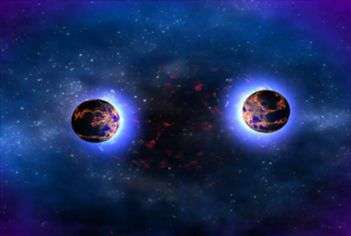Cosmic explosion spotted in neighbouring galaxy

(Phys.org) —NASA's Swift satellite reported an enormous explosion occurred this morning at 8.15 AEST in our neighbouring galaxy, Andromeda. This explosion is known as a Gamma Ray Burst (GRB), one of the most powerful explosions in the Universe.
The exact cause is unknown but thought to be an explosion from when two Neutron Stars collide. These Neutron Stars are the dead cores of massive stars, with the mass of our Sun crushed into the size of a small city. When they merge together, the explosion is so powerful it can be seen from across the Universe.
Swinburne University of Technology astronomer Dr Alan Duffy says these GRBs explosions are so large that if they occur within our galaxy they can potentially trigger mass extinctions on Earth.
"Telescopes around the world are currently trained on the Andromeda galaxy looking in all wavelengths of light to learn more about this once-in-a-lifetime event.
"The explosion seen in light will also potentially be visible in gravitational waves, a key prediction of Einstein, ending a long quest to detect these ripples in space time. Unfortunately the world-wide facility for detecting these events, LIGO, is currently shut down for an upgrade, missing out on the explosion and a potential Nobel Prize winning discovery.
"The night sky seen in high-energy light is continuously flashing as titanic explosions, bright enough to be seen from across the length of the Universe, erupt and travel to us. It's a violent world out there.
"The most astounding aspect of today is that colliding Neutron Stars exploded in less than a second, shining out in Gamma Rays which have travelled undisturbed for 2.5 million years until hitting NASA's Swift satellite, within minutes telescopes across the globe were tracking it and an hour later people around the world were following it on Twitter. It's been hectic.
"Typically the Universe moves slowly, with enormous galaxies swirling around in slow motion as measured by human standards and then just occasionally something will go bang and it's a race against time to record and learn everything you can," Dr Duffy said.
"Whatever this explosion ultimately was caused by, and they are many exciting and exotic possibilities, it's made a lot of astronomers have a very exciting day."
Provided by Swinburne University of Technology





















